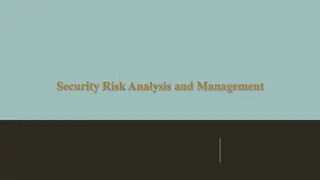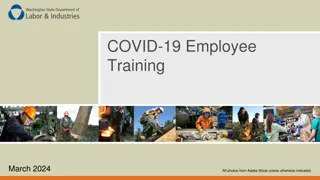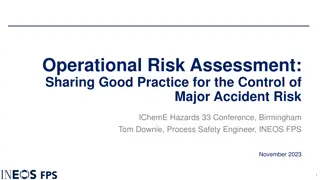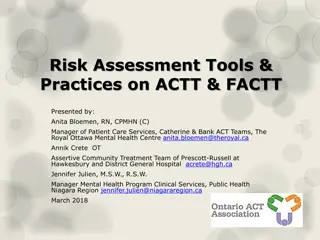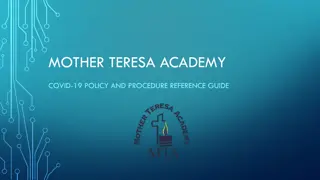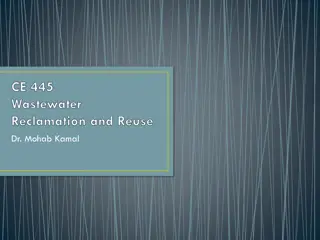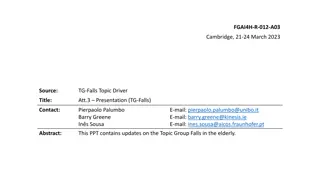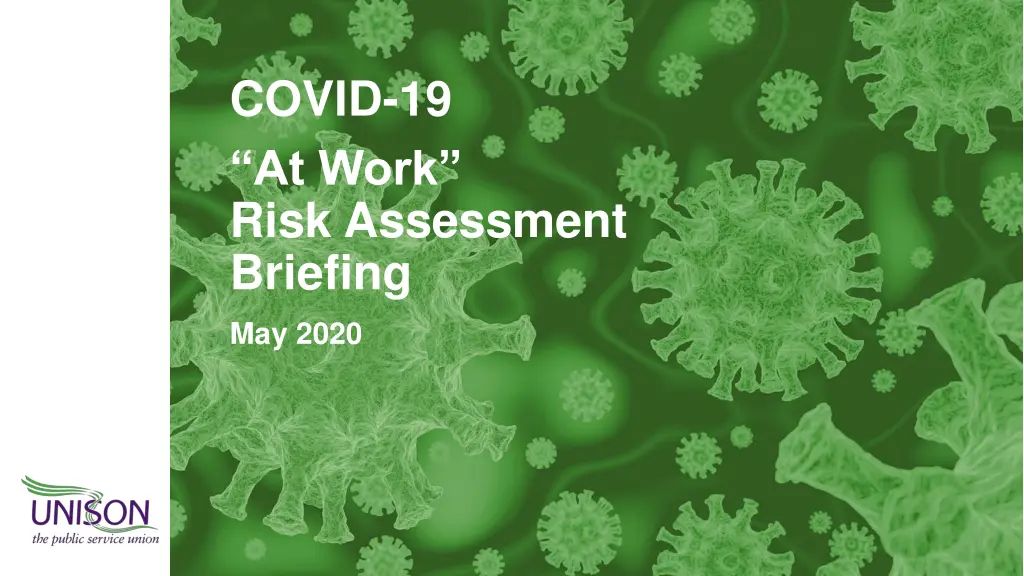
Understanding COVID-19 and Workplace Safety Measures in 2020
Learn about the impact of COVID-19 on workplaces, its transmission, effects on individuals, and government guidelines for a safe return to work. Discover what "COVID Secure" means and the importance of risk assessment in managing the virus at work.
Download Presentation

Please find below an Image/Link to download the presentation.
The content on the website is provided AS IS for your information and personal use only. It may not be sold, licensed, or shared on other websites without obtaining consent from the author. If you encounter any issues during the download, it is possible that the publisher has removed the file from their server.
You are allowed to download the files provided on this website for personal or commercial use, subject to the condition that they are used lawfully. All files are the property of their respective owners.
The content on the website is provided AS IS for your information and personal use only. It may not be sold, licensed, or shared on other websites without obtaining consent from the author.
E N D
Presentation Transcript
COVID-19 At Work Risk Assessment Briefing May 2020
What is COVID-19? We are currently experiencing a Global Pandemic of COVID-19, also known as coronavirus . This is a highly infectious and potentially dangerous virus. Other coronaviruses include the common cold and influenza. The main symptoms of coronavirus are: a high temperature this means you feel hot to touch on your chest or back (you do not need to measure your temperature) a new, continuous cough this means coughing a lot for more than an hour, or 3 or more coughing episodes in 24 hours (if you usually have a cough, it may be worse than usual) Loss of smell or taste Symptoms vary, and at least in this early stages, people who have the virus have been know to display very mild symptoms (such as a runny nose.
When/how is COVID-19 transmitted? COVID-19 is a new disease and there is still a lot we are still finding out about it. It is currently believed the virus spreads by attaching itself to droplets in the air that then enter the body through mucus membranes such as in the eyes, nose and mouth. It is important that measures are taken to prevent people showing symptoms passing on the virus to others. However, it is possible you can pass on the virus without or before showing any symptoms.
Effects of COVID-19 People with COVID-19 generally develop signs and symptoms, including mild respiratory symptoms and fever, on an average of 5- 6 days after infection. Most people infected with COVID-19 virus have a mild illness and recover. COVID-19 can make some people very ill. More rarely, the disease can be fatal. Older people, and those with pre-existing medical conditions (such as high blood pressure, heart problems or diabetes) are more vulnerable. There is currently no vaccine available for COVID-19 COVID-19 is a hazard in the workplace that employers are required to manage.
COVID-19 and Work In England the government message has changed from stay at home to stay alert and to work from home where possible . As part of this, workers who are not able to work from home are being asked to return to work, where their workplace is open. Many key public service workers have continued to work and have already agreed safe working practices. Others have successfully worked from home and will continue to do so. The governments in Scotland, Wales and Northern Ireland have continued to apply the stay at home message, with a few exceptions (such as staff working in garden centres). This has meant workers are carrying on as before
What is COVID Secure? This is a phrase used by the UK government to ensure that employers in England make their work operations as safe as possible for employees when they return to work. UNISON has already reached agreement with many employers which provide more detailed and comprehensive guidance, and these should still apply. However the 5 key points to implementing COVID Secure working practices are: 1. Work from home, if you can 2. Carry out COVID-19 risk assessment in consultation with workers and trade unions 3. Maintain 2 metres social distancing, wherever possible 4. Where people cannot be 2 metres apart, manage transmission risk 5. Reinforcing cleaning processes UNISON and other health unions have produced a 9-Point Blueprint for the safe opening up of NHS services.
Why Risk Assess? A risk assessment is a systematic examination that your employer must conduct of the task, job or process that you carry out at work. This is for the purpose of identifying the significant hazards, the risk of someone being harmed and deciding what further control measures must be taken to reduce the risk to an acceptable level. Employers have a duty to risk assess under the following legislation: Health and Safety at Work etc. Act 1974 The Management of Health and Safety at Work Regulations 1999
Rights of safety reps Employers have a legal duty to consult with Safety Reps on anything affecting their members safety. This would include the outcomes of any risk assessment. Safety reps also have the right to conduct their own workplace inspections It is good practice in the current situation for employers and trade unions to jointly conduct workplace inspections, and agree the outcomes of any risk assessments. Employers must also consult with safety reps on introduction (or planning of) any new technology (such as testing for COVID-19)
COVID-19 hazards, risks & risk assessment A COVID-19 secure workplace must have a risk assessment carried out and consider hazards and risks. A risk assessment is a systematic method of looking at work activities, considering what could go wrong (this includes thinking about who can be harmed and how, and how badly they could be affected), and deciding on suitable control measures. These control measures are designed to eliminate, reduce or minimize the risks of loss, damage or injury in the workplace A hazard is something that can cause harm. A risk is the chance, high or low, that any hazard will actually cause somebody harm.
COVID-19 Hazards, Risks & Risk Assessment The six main categories of workplace hazards. Biological hazards - include viruses (such as COVID-19), bacteria, insects, animals, etc., that can cause adverse health impacts. Chemical hazards - hazardous substances that can cause harm. These hazards can result in both health and physical impacts. Physical hazards - environmental factors that can harm an employee without necessarily touching them. Safety hazards - create unsafe working conditions. Ergonomic hazards - a result of physical factors that can result in musculoskeletal injuries. Psychosocial hazards - include those that can have an adverse effect on an employee s mental health or wellbeing.
Areas to Risk Assess Premises Practices People This order allows the organisation to implement control measures on a global scale within their premises, to adjust practices across the board and then ensure that any people with special issues or access needs are assessed in line with their own personal circumstances Premises Practices People where are they /how large are they/ what is the capacity toilets and welfare facilities and communal areas (inc. lifts & stairs and access points) what is your business and how is it conducted do you deal with the public or any other external groups alongside your own staff who are they are they vulnerable or particularly at risk or have access needs how do they get to their place of work
Principles of Risk Assessment Identify the Hazard Decide Who Can Be Harmed And How Review And Update Record The Findings And Implement Them Evaluate The Risk And Decide On Control Measures
Identify the hazards: how are people exposed to COVID-19? COVID-19 as a hazard is transmitted people to others, either by direct contact with infected persons, or by contact with contaminated objects and surfaces. Routes to transmission are throughdroplets in the air that then enter the body through mucus membranes such as in the eyes, nose and mouth. These microscopic virus droplets can be transmitted when people breathe, speak, sneeze and cough. You are at greatest risk when you are within two metres of an infected person. They can also be transmitted by someone touching a surface that the droplets have rested on and then going on to touch their faces, eyes nose or mouth. In heavily contaminated areas there may also be a risk of inhaling these droplets from the air when they are disturbed. The more people and places you come into contact with the more likely you are to be exposed to the virus.
COVID-19: Where are most likelihood sources of infection in the workplace? Entrance areas Doors (and how they open / close) Toilets & (hand) washing facilities Lifts & stairs Bedrooms/personal living spaces, Wards, classrooms, office space Kitchens & other food preparations areas Meeting rooms, restaurants/eating/drinking areas and other communal areas Halls/passageways Driving cabs (transport workers) Crowded outdoor areas such as parks, gardens, play areas & courtyards
COVID-19 Hazards in workplace created by tasks, environment & people Work tasks Are you facing each other? How many colleagues do you come into contact with? Do you come into contact with members of the public/service users? If you are not normally working from are there still some tasks you can do at home? Working environment Desk spacing and layout - is there sufficient distance? How many people are there in your area and in the building? Individual staff Reasonable Adjustments/personal circumstances Pre-existing health conditions or risk factors
Decide who might be harmed? Any risk must assess how and who may be at most risk of harm. Those most at risk of harms from COVID-19 are: Those classed as at high risk (extremely vulnerable) (see below) Those classed at moderate risk Older workers (although those over 70 are most at risk the older you the more at risk you are) Those with poorer health (even if not classed as high or moderate risk the poorer your health the more at risk you are) Ethnic origin: Significant data suggests that black people are disproportionally affected by COVID-19 Regional variations: There is increasing evidence of significant regional differences in the rate of infection .
Evaluate the risk and decide on the control measures (1) Having identified the hazards, employers must then decide how likely it is that harm will occur; i.e. the level of risk and what to do about it. Where possible they must eliminate the risk. If that is not possible employers must do everything that is reasonably possible to minimize it. It is not possible to completely eliminate the risk of you catching COVID-19, but it is possible to eliminate this risk of infection in your employer s workplaces by working from home.
Evaluate the risk and decide on the control measures (2) Where working from home is not possible employers can reduce the risk. Some examples of actions employers can take are: Applying strict hygiene & social distancing Reducing the number of people you come into contact with Organising the workplace so that you are facing away from colleagues Erecting barriers, such as Perspex screening between you and service users. Organising your tasks / workload so that you can work from home wherever it is possible. possible.
The Risk Assessment Matrix An employer should use this or a similar matrix to assess how serious a risk the spread of COVID-19 is. They do this by the multiplying the consequence by the likelihood. In this case any score above 8, the risk is high, and above 16 it is extreme.
Hierarchy of Control They should use what is called a Hierarchy of Control is used to rank how effective controls can be and the order in which they should be used. Although it is often called a hierarchy they must consider all measures, and how they effective they are when applied together. Any control measure (including PPE) should be funded by the organisation
How to minimise risk example Control Step Control Measure Eliminate Work from home, and don t come into work unless you have to, to avoid unnecessary exposure Substitute Substitute personal contact by for example providing information online or by phone, using technology such as Skype to conduct meetings. Engineering Controls Erect Perspex sneeze screens to separate desks in office to provide a barrier Enhance office cleaning regime. Regular testing of workers and service users for COVID-19 Administrative Controls Apply strict social distancing. Have team members in on a rota basis at different times to observe social distancing. Have the same team members on each rota will minimise exposure further by reducing the number of people they come into contact with. Apply strict social distancing to communal areas, and in some cases close them. Restrict access to lifts (taking into account mobility issues) and make staircases one-way to observe social distancing Personal Protective Equipment (PPE) PPE must be used by all those providing direct, close up (within 2 metres) personal care to service users, and considered where social distancing is not possible. See UNISON COVID- 19 PPE guide on website. Employers should provide anti-bac wipes and instructions on cleaning / hygiene for all staff.
Shielded Workers Wherever possible UNISON has negotiated agreements that enable these groups to work or stay at home Employers have a duty to shield those most at risk. This includes: have had an organ transplant are having chemotherapy or antibody treatment for cancer, including immunotherapy are having an intense course of radiotherapy for lung cancer are having targeted cancer treatments that can affect the immune system have blood or bone marrow cancer (such as leukaemia, lymphoma or myeloma) have had a bone marrow or stem cell transplant in the past 6 months, or are still taking immunosuppressant medicine have been told by a doctor they you have a severe lung condition (such as cystic fibrosis, severe asthma or severe COPD) have a condition that means they have a very high risk of getting infections (such as SCID or sickle cell) are taking medicine that makes them much more likely to get infections (such as high doses of steroids) were born with a serious heart condition and are pregnant
Moderate risk Employers should consider additional measures to protect these groups are 70 or older are pregnant have a lung condition that's not severe (such as asthma, COPD, emphysema or bronchitis) have heart disease (such as heart failure) have diabetes have chronic kidney disease have liver disease (such as hepatitis) have a condition affecting the brain or nerves (such as Parkinson's disease, motor neurone disease, multiple sclerosis or cerebral palsy) have a condition that means they have a high risk of getting infections are taking medicine that can affect the immune system (such as low doses of steroids) are very obese (a BMI of 40 or above)
Implementation and Review Risk Assessments are live documents, they should be reviewed regularly and at least when there has been any change in circumstances or risk factors. Once the findings have been recorded, a schedule for implementation should be drawn up. Things your employer will take into consideration with regards to timescales are: Risk score both initial and residual Benefit / impact of implementation Time to implement Cost to implement (reps will want to ensure these do not override staff safety) There may be some low cost-high impact control measures that could be done first the quick wins! Once timescales are agreed, the risk assessment should be regularly reviewed and updates ensuring it is in line with latest guidance. It should be reviewed at least annually if there are no updates to be implemented.
Useful Information UNISON Website: https://www.unison.org.uk/coronavirus-rights-work/ UNISONs Risk Assessment information https://www.unison.org.uk/get- help/knowledge/health-and-safety/risk-assessment/ UNISON s Risk Assessment Guide https://www.unison.org.uk/content/uploads/2014/07/On-line- Catalogue221002.pdf UK Government Website: https://www.gov.uk/coronavirus Signposting to more detailed occupational based guidance found on UNISON website above Scottish Government Website: https://www.gov.scot/coronavirus-COVID-19/ Cymru / Wales Government Website: https://gov.wales/coronavirus Northern Ireland Government Website: https://www.health-ni.gov.uk/coronavirus Health and Safety Executive Website: https://www.hse.gov.uk/news/coronavirus.htm https://www.hse.gov.uk/risk/controlling-risks.htm TUC Website https://www.tuc.org.uk/resource/COVID-19-coronavirus-guidance-unions- updated-16-april

